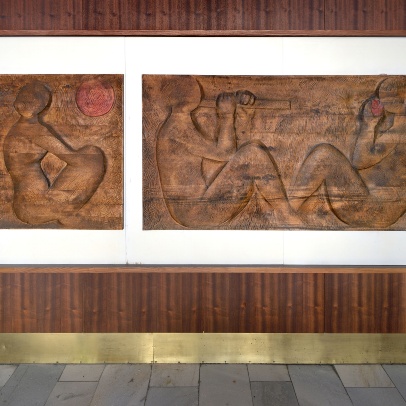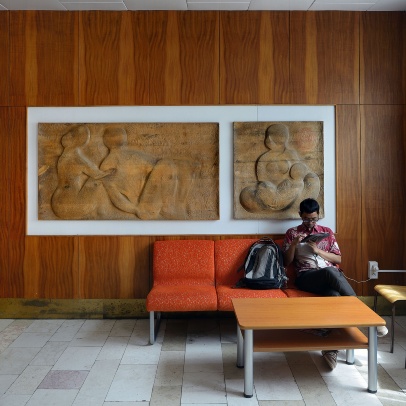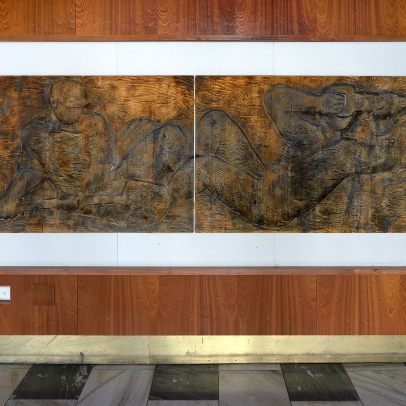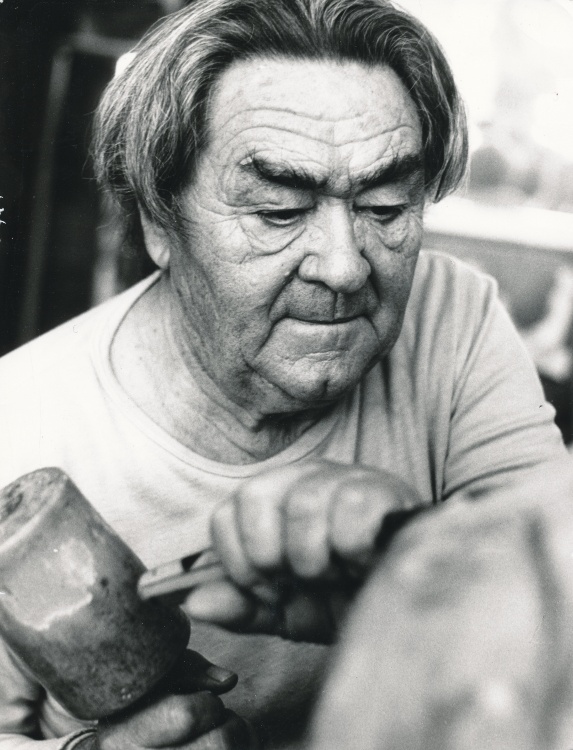Name: Youth, Folk Song, Miners/Work, Love, Family
Author: Jindřich Wielgus
Dating: 1981
Location: in the interior in the entrance areas of individual blocks of the VŠB-TUO halls of residence in Ostrava-Poruba
Execution: wooden relief panels
C block – Youth, 98 x 90 cm and Folk Song, 98 x 180 cm; stained wood; marked JW on the left panel in the upper left corner in the engraved circle
D block – Miners/Work, 152 x 295 cm; stained wood; marked JW in the upper left corner in the engraved circle
E block – Love, 97 x 180 cm and Family, 97 x 90 cm; plain wood with no staining; marked 1) on the right panel in the upper left corner in the engraved JW circle, 2) on the bottom left panel in the middle engraved JW by the wrapping in the relief structure
LOST IN A LONG CORRIDOR
The trio of low reliefs with a figural composition includes the stages of life unfolding from youth through work to a harmonious family. On the left side of the double relief Youth and Folk Song, there is a nude rendition of a girl dreamily looking up towards the sun, and on the right side, there is a couple sitting across from each other shown in profile – a young man-piper and a girl biting an apple. The Miners/Work relief depicts a pair of men working in the mine; the miner on the left is shovelling coal, half-sitting; the figure on the right, half-lying, is mining coal with a pneumatic drill. The remaining double relief, Family and Love, remained, compared to other panels, without polychromy. The left part shows a nude couple leaning towards each other; the right part shows a mother sitting with her child.
After rather unfortunate attempts on non-figurative work (including Stela from 1966–1967 in the entrance courtyard of the VŠB halls of residence, in cooperation with Jan Kudláček), Wielgus returned to the modelled human figure. This work also includes wooden reliefs, five of which found their place in the entrance vestibules of interconnected buildings of the VŠB halls of residence. In the 1980s, the author draws on earlier certainties, especially in relation to the human body. The figures, especially women in his wooden paintings, are mostly modelled in low relief (bas-relief). However, the shade effects in sharply undercut contour lines evoke the illusion of a high relief (haut-relief) and a deeper space than is in the carving material.
The same technique was also used in the reliefs located at the premises of the University halls of residence. All of them have a similar overall format, with the exception of Miners/Work relief where both panels are combined into one complex of images. Otherwise, other double reliefs depicting more intimate subject matter, Youth and Folk Song, as well as Family and Love, are composed of two separate parts, aligned in a 2:1 format. All three works of art are set on a white background and united in simple non-profiled frames. Although separated from each other by interconnecting corridors, they are connected through the subject, which lies within the socialist realism doctrines: happy youth age full of promise, as well as work and family, are perceived as the perspective of the socialist society. In the “normalization” period, however, the author failed to fulfil the ideological direction with respect to the formal elaboration. He skipped a detailed description, shaped the bodies in uniting curves, and lyricizes the connection between figures – with the exception of the work theme. In the case of a musical thematic, the poetic aspect is intensified using a staining technique accentuating the red sun and apple. For some reason, the last, third relief, was not executed in a colour version. A dreamy girl figure, a mother with her child, or a music theme, repeat in Wielgus’s work. The similar relief panels can be found in the Prague city gallery, where Mother with Her Child or Song of Rose are genetic predecessors of the Poruba collection. Similarly, Healthy Environment (1986) in the neighbouring premises of the University Hospital repeats the connection of a mother and a child in a full-dimensional form as a stone sculptural group.



